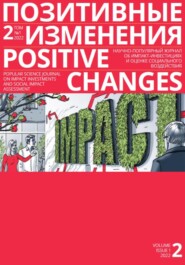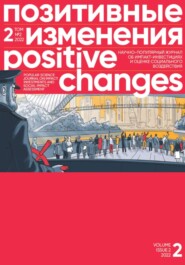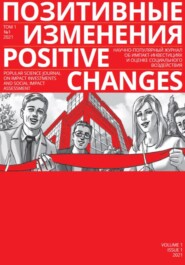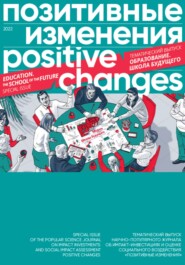По всем вопросам обращайтесь на: info@litportal.ru
(©) 2003-2025.
✖
Позитивные изменения. Города будущего. Тематический выпуск, 2022 / Positive changes. The cities of the future. Special issue, 2022
Настройки чтения
Размер шрифта
Высота строк
Поля
«Работы в деревне нет, как нет ни магазина, ни клуба, ни почты. Наш проект направлен на то, чтобы дать возможность жителям нашей деревни самореализовать себя в ремесле, поделиться своими знаниями и умениями друг с другом, обучить приемам и возможностям продажи своих изделий. И помочь им увидеть возможность получать дополнительный доход от продажи изделий ручной работы».
«Экономические» проекты, реализуемые в рамках «Солидарных сообществ», пока не могут претендовать на роль драйверов развития территорий. У них есть несколько общих черт:
• Это проекты энтузиастов, непрофессионалов в области ведения бизнеса;
• Проектам не хватает прежде всего планирования – ни в одной из заявок перспективы не только не описаны, но и не просматриваются. Это эксперименты;
• Обращает на себя внимание, что ни один из проектов, кроме заявки Усть-Почи, не ориентирован на внешние рынки. Участники отсекают себя от широкой аудитории.
Но при должном развитии и поддержке они могут стать более эффективными.
ВМЕСТО ЭПИЛОГА
Развитие территории – комплексное понятие. В него входят и экономические показатели, и социальная активность жителей, и инфраструктурные элементы (ФАПы, школы, дороги и т. д.). Безусловно, в широком смысле развивать территорию, опираясь исключительно на действия и ресурсы активистов и ABCD-подход, невозможно. Но они могут запустить этот процесс, превратив депрессивную унылую территорию в нечто совершенно иное.
По версии национальной инициативы «Живые города» 1 % населения любой территории – это лидеры изменений. Те, в чьих силах инициировать и направить действия окружающих либо во благо, либо в другую сторону. При всем разнообразии и противоречивости теоретических и практических подходов к понятиям сообществ, действия таких людей – неравнодушных, сочувствующих, упорных и по-хорошему упертых – видны по всей стране, причем в разных сферах.
Они создают «телефонные цепи», помогая одиноким бабушкам восстановить или выстроить заново круг общения и не оставаться в изоляции.
Они собирают по крупицам истории бабушек и дедушек и создают Музей забытых деревень.
Они помогают родителям детей с ОВЗ получить хотя бы небольшую передышку и поддержку, делают события, куда можно попасть на коляске или где можно на равных с другими людьми смотреть спектакль в полной темноте.
Они помогают подросткам найти свое место в городе – вместе с ними из картонных коробок и пакетов сооружая демо-версии тех пространств, о которых ребята мечтают. Так, что потом они появляются уже в реальном воплощении.
Сообщества могут быть разными: только появившимися или существующими десятки лет. Это могут быть домовые / дворовые чаты из городов или общий чат деревни на 108 человек. Это могут быть объединения профессионалов и лидеров сферы или просто компания старых друзей, по доброте душевной помогающих приютам или сортирующих мусор по личным убеждениям.
Весь многолетний опыт фонда показывает нам: для того, чтобы изменить мир к лучшему, нужно просто начать действовать.
Благодарность за помощь в создании материала автор выражает: Марии Морозовой, Ирине Калистратовой, Тамаре Славинской, Ивану Тарасову, Дмитрию Лисицину, Петру Иванову, Елене Серебренниковой, Веронике Суворовой, Дмитрию Машину, Анне Кузнецовой.
Communities as a Driver of Territorial Development. The Solidarity Communities Project Experience
Participatory design, community organization, change leaders, and citizen engagement are the concepts that have become firmly established over the past three years when it comes to territorial development. It is worth noting that in the public view all these terms are associated more with urbanism and landscaping than with the social sphere. So what are communities and can they develop an area? The Timchenko Foundation, whose program to support cultural projects has become a driver in small territories development, shares its views and experience.
Evgeniya Rudina-Ladyzhets
Head of the Solidarity Communities Pilot Project, Timchenko Foundation
BACK TO BASICS
Despite the fact that the concepts of "community," "social cohesion" and "social capital" have been developed actively since the 1980s by scholars in various fields, from psychology to economics, no unified approach to them has been established to date. Moreover, since the early 2000s, Western scholars (Claude Fischer, Michael Woolcock) have generally criticized these concepts as having acquired too broad a meaning and thus losing their value and specificity. There aren’t too many works by Russian scientists devoted to the topic of communities and related concepts, and they are mainly based on studies of urban environments and neighborhood communities (F. G. Karasev, E. S. Shomina, T. A. Guzhavina). One way or another, one thing most researchers agree on is that both social capital as a set of strong and weak ties, and the association of people into a cohesive group by a number of properties, do not happen by themselves, but for the sake of achieving some kind of common benefits in the future.
According to a study commissioned by the Timchenko Foundation in 2020–2021 and implemented by Strelka KB in conjunction with guest experts, three main interpretations of the term "community" run the golden thread in the history of its use: connection to a place, common interests and social solidarity, and social activism. In our work, we try to combine these interpretations.
By combining these approaches, we arrive at the following definitions:
A local community is a community that brings together people living together in the same area. The smaller the settlement, the tighter the social ties that unite the residents of the community (the classic model of a local community is a rural settlement). In large cities, local communities start to be fragmented into blocks and houses, and begin to play a smaller role in the life of the society.
Engagement is the involvement of all stakeholders affected by the change – residents of the nearby area, local communities, activists, representatives of administrative authorities, local businesses, experts and other stakeholders in the project – in the decision-making process to define the goals and objectives of a territory, to identify real problems and needs of the people, to make joint decisions, resolve conflicts and increase the effectiveness of common actions.
Solidarity is the recognition of the people’s common interests and the solution of common problems based on mutual understanding, mutual respect and mutual assistance, and the sharing of responsibilities.
Reflexive solidarity (this concept will come in handy towards the end) is the conscious overcoming of the boundary between representatives of different groups, aimed at improving the quality of life of all residents of the territory, including representatives of vulnerable groups.
Each of these concepts has extensive justification and detailed wording in the Timchenko Foundation’s internal strategy.
ABOUT SMALL TERRITORIES
About 40 % of the Russian population lives in remote rural areas, also known as "small territories." For various reasons, the small territories experience a shortage of resources: lack of funding, remoteness from regional centers, lack of access to modern knowledge and technology, poorly developed infrastructure. In the experience of the Foundation, short-term projects originally run by activists in the interests of themselves and their immediate circle, can eventually into long-term systematic work that affects the interests of all residents. Since 2015, the Foundation conducts the Cultural Mosaic of Small Towns and Villages contest, which serves as an example that sociocultural initiatives can become the driver of small area development by bringing the community together, creating an innovative creative environment, and adding relevance to history, heritage, and traditions.
The Cultural Mosaic is a three-year cycle during which teams gain experience from implementing their first project to creating a network of partners in their territory and building a center for sociocultural development. As the sociocultural environment improves, local residents develop a positive attitude toward their small motherland, and through their engagement in the process of change they begin to feel ownership and responsibility for the development of the place where they live. Over the eight years of the competition, the Foundation has developed important principles for achieving sustainable, long-term results.
This includes, on the one hand, a dense support of project leaders, and on the other hand – a step-by-step program for the development of winning teams.
459 projects from 65 regions received support during the period of the competition. Thanks to these projects:
• new jobs were created and the number of self-employed people increased: 705 new jobs;
• volunteer activity has grown: more than 7,100 volunteers a year;
• partnership with the government and business is strengthened – local associations and strategic working groups for territorial development are being created;
• financing is raised: 223 million rubles is the amount of co-funding raised for our projects; funding by Timchenko Foundation amounted to 407 million rubles (as of the end of 2021). Project leaders gain more experience and maturity year after year, their level of social capital increases, the results (both short-term and long-term) become more successful, giving a firm footing, partners appear, and some even manage to engage investors. The country discovers new small territories – Yuzha, Tulun, Totma, Rybinsk, Uryupinsk, and many others.
However, in eight years, only 31 projects have advanced so far as to become centers of sociocultural development that work systematically with the entire local community in all its diversity, not with isolated target groups or topics. Why did this happen?
The catch was the notion of leadership in communities. The local communities, which is important to note.
ABOUT COMMUNITY LEADERSHIP
The traditional concept of a leader describes a person who enjoys great, recognized authority, has influence in a group, organization, team, or unit that manifests itself as controlling actions. This classic notion of a leader is appropriate for an organization; it is also appropriate for initiating communities that are just starting to take shape. Perhaps this understanding of the leader can also be found in a number of professional communities (aka communities of interest), where there is invariably one person among the "equals" in status or level of interest, who takes responsibility for organizing the entire group.
If you break down most of the collaboration projects in a small territory, they turn out to be, in their content and meaning, the second type of communities – professional ones, where the strong team up with the strong, because it is beneficial for both sides.
However, this approach to leadership does not apply to local communities – which consist of people of different ages, social statuses, experiences, interests, principles, and values residing in the same area. How can one person, who has no legal, administrative and financial leverage, coordinate the interests of several hundred or even thousand different people? How can they balance the interests of business, government, activists, children, the elderly, young parents, and many others? All the while without forgetting themselves, their family, ambitions and goals. The answer is simple – there is no way.
Marshall Ganz at Harvard University’s Kennedy School of Government, who has studied a large number of approaches to civil society organization processes, gives this notion of leadership specifically for communities:
• a leader is a person who takes responsibility to enable others in the community to achieve their common goal in the face of uncertainty. Here the focus naturally shifts from one person’s interests, ambitions and plans to the "cultivation" of a leadership network that grows continuously, making the community more sustainable. This reduces the risk of the leader burning out or moving, because the focus is on universal values that bring different people together. Not the interests of any professional group. Not a solution to an urgent problem that literally forced people to come together.
This understanding of leadership is used by Universal University, Strelka Online Institute, the Agency for Strategic Initiatives, the "People Make a Place" Urban Change Workshop, and other organizations in different areas – for territorial development, creative industries, and volunteer projects of various kinds. This fundamentally changes the approach to both the accompanying program for those who would like to work with the community and the focus for which they can come together.
In essence, the leader here is no longer a leader, but rather a facilitator, a coordinator who gradually moves further and further away from the "center of control," without preventing other active residents from expressing themselves and taking some responsibility for the common future and present. The self-development model of local communities assumes that the community itself (not just one person) is able to determine its priority problems, the forms and methods of their solution, the timing of specific projects. This is precisely the type of community that should manifest the very ideal stage of solidarity according to Jodi Dean’s classification – reflective solidarity, because the beneficiaries (various vulnerable groups, among others) are not simply engaged in the action from the start, but are full participants of the action.
When working with a local community, different principles come to the fore, because unification is most often about improving the quality of life for all residents in the entire area:
• Sustainability, so as to minimize the risks associated with changes in the financing structure or composition of participants. They are aimed at making the community self-replicating (i.e., attracting new members), strengthening internal and external linkages, and receiving funding from diversified sources;









